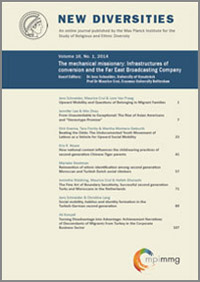From Unassimilable to Exceptional: the Rise of Asian Americans and “Stereotype Promise”
by Jennifer Lee (University of California, Irvine) and
Min Zhou (Nanyang Technological University, Singapore)
To cite this article: Lee, J., & Zhou, M. (2014). From Unassimilable to Exceptional: the Rise of Asian Americans and “Stereotype Promise”. New Diversities, 16(1), 7–22. https://doi.org/10.58002/pnfm-zc36
Less than a century ago, Asian Americans were described as illiterate, undesirable, and unassimilable immigrants, yet today, they have the highest educational outcomes, highest rates of intermarriage, and lowest rates of residential segregation. Some scholars and pundits have attributed the dramatic change in their status to Asian culture and values. Focusing on the educational attainment of 1.5- and second-generation Chinese and Vietnamese, we argue that there is nothing essential about Asian culture or values that promote exceptional outcomes, but, rather, a circular process unique to contemporary Asian immigrants in the United States. Contemporary Asian immigrants are, on average, highly-educated and highlyselected—what we refer to as “hyper-selectivity.” Because of their hyper-selectivity, Asian immigrants import class-specific cultural institutions and practices from their countries of origin, including a sophisticated system of supplementary education, which they recreate in the United States. Consequently, stereotypes about Asian Americans are positive, and become a form of symbolic capital, which result in “stereotype promise”—the promise of being viewed through the lens of a positive stereotype, which, in turn, can enhance the performance of Asian American students. This generates a self-fulfilling prophecy of “Asian American exceptionalism”, and reproduces inequalities at the high end of the educational distribution, giving Asian American students a distinct advantage in the domain of education.
Keywords: Asian Americans, second generation, education, stereotypes, stereotype promise
|
